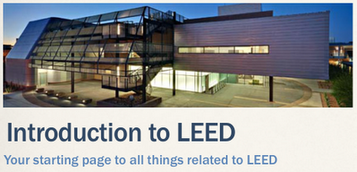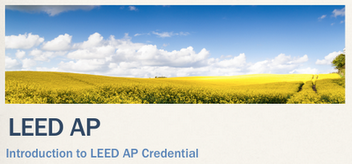
LEED stands for Leadership in Energy and Environmental Design.
Getting green through LEED goes back to 1993, when the non-profit organisation, the USGBC (United States Green Building Council) was established to promote and grow sustainable building practices. To market their concept of building green, they had to create a system to introduce the idea to the industry.
Two years later after the USGBC was established, LEED was created by the USGBC in 1995 as a rating system to give the market tools, measurable performance standards, and strategies to create sustainable buildings. Not only are architects, landscape architects, real estate professionals, engineers and owners using the LEED rating system to produce more sustainable buildings, many government agencies have adopted the LEED system as a standard or offer incentives for LEED certification seeking projects. A recent LEED certified government building includes the Clinton library which received a LEED Platinum rating
Getting green through LEED goes back to 1993, when the non-profit organisation, the USGBC (United States Green Building Council) was established to promote and grow sustainable building practices. To market their concept of building green, they had to create a system to introduce the idea to the industry.
Two years later after the USGBC was established, LEED was created by the USGBC in 1995 as a rating system to give the market tools, measurable performance standards, and strategies to create sustainable buildings. Not only are architects, landscape architects, real estate professionals, engineers and owners using the LEED rating system to produce more sustainable buildings, many government agencies have adopted the LEED system as a standard or offer incentives for LEED certification seeking projects. A recent LEED certified government building includes the Clinton library which received a LEED Platinum rating
Why go LEED?
In addition to government incentives, the expanded client potential and better building performance, there is the bigger picture of the need to reduce our carbon footprint on the environment. If we consider what it takes to produce anything from the pen you use to an entire building, it is no wonder that the net return to the environment is negative. Following LEED criteria is an effort to build our awareness of the impact to the environment we cause through our actions. It is just a starting point. There are usually two basic reasons for taking LEED:
- Professional/career investment
- Education about LEED and sustainability

The LEED AP credential affirms your advanced knowledge in green building as well as expertise in a particular LEED rating system. All LEED AP with specialty credential holders are required to maintain their credential through continuing education.

LEED AP Building Design + Construction (LEED AP BD+C) The LEED AP BD+C credential suits professionals with expertise in the design and construction phases of green buildings serving the commercial, residential, education and healthcare sectors. The specialty denotes practical knowledge in the LEED for New Construction, LEED for Schools and LEED for Core and Shell rating systems. Access the candidate handbook for exam policies and procedures. |

LEED AP Operations + Maintenance (LEED AP O+M) The LEED AP O+M credential distinguishes professionals implementing sustainable practices, improving performance, heightening efficiency and reducing environmental impact in existing buildings through enhanced operations and maintenance. The specialty denotes practical knowledge in the LEED for Existing Buildings: Operations and Maintenance rating system. Access the candidate handbook for exam policies and procedures. |

LEED AP Interior Design + Construction (LEED AP ID+C) The LEED AP ID+C credential serves participants in the design, construction and improvement of commercial interiors and tenant spaces that offer a healthy, sustainable and productive work environment. The specialty denotes practical knowledge in the LEED for Commercial Interiors rating system. Access the candidate handbook for exam policies and procedures. |

LEED AP Homes The LEED AP Homes credential is suited for those involved in the design and construction of healthy, durable homes that use fewer resources and produce less waste. The specialty denotes practical knowledge in the LEED for Homes rating system. Access the candidate handbook for exam policies and procedures. |

LEED AP Neighborhood Development (LEED AP ND) The LEED ND credential applies to individuals participating in the planning, design and development of sustainable, pedestrian-friendly neighborhoods. The specialty denotes practical knowledge in the LEED for Neighborhood Development rating system. Access thecandidate handbook for exam policies and procedures. |
Determine which LEED credential you want to achieve.
In order to receive the proper LEED training, you need to decide which LEED credential is right for you. There are currently two levels of LEED credentials: LEED Green Associate and LEED Accredited Professional. Think of the levels as if they were a high school diploma and bachelordegree; you must obtain onefirst before you can obtain the other. The LEED Green Associate credential is the first, more general, level like a high school diploma. The LEED Accredited Professional credential is the next, more technical, level like a bachelor degree.
You must first pass the LEED Green Associate exam before you can take a LEED Accredited Professional exam.
You must first pass the LEED Green Associate exam before you can take a LEED Accredited Professional exam.
Ensure you are eligible to take a LEED exam.
In order to be eligible to take the LEED Green Associate exam you must have experience in at least one of the following forms: involvement on a LEED project, employment in a sustainable field of work, or engagement in an education program that addresses green building principles. If you do not currently meet any one of these three options, it is easy to become eligible by engaging in an education program that addresses green building principles. For example, if you take an online course with Planet Principles you will receive a Certificate of Completion to submit with your LEED Green Associate exam application so you will be eligible for the LEED exam.
In order to be eligible to take a LEED Accredited Professional exam you must have been involved with a LEED project within three years of the date you apply to take the LEED AP exam. This experience must be documented in LEED Online or in the form of a letter of attestation that describes your involvement on the LEED project. For more information about eligibility requirements, visit the Green Building Certification Institute (GBCI) website. GBCI oversees the development of all the LEED exams and is in charge of the LEED credentialing process.
In order to be eligible to take a LEED Accredited Professional exam you must have been involved with a LEED project within three years of the date you apply to take the LEED AP exam. This experience must be documented in LEED Online or in the form of a letter of attestation that describes your involvement on the LEED project. For more information about eligibility requirements, visit the Green Building Certification Institute (GBCI) website. GBCI oversees the development of all the LEED exams and is in charge of the LEED credentialing process.

